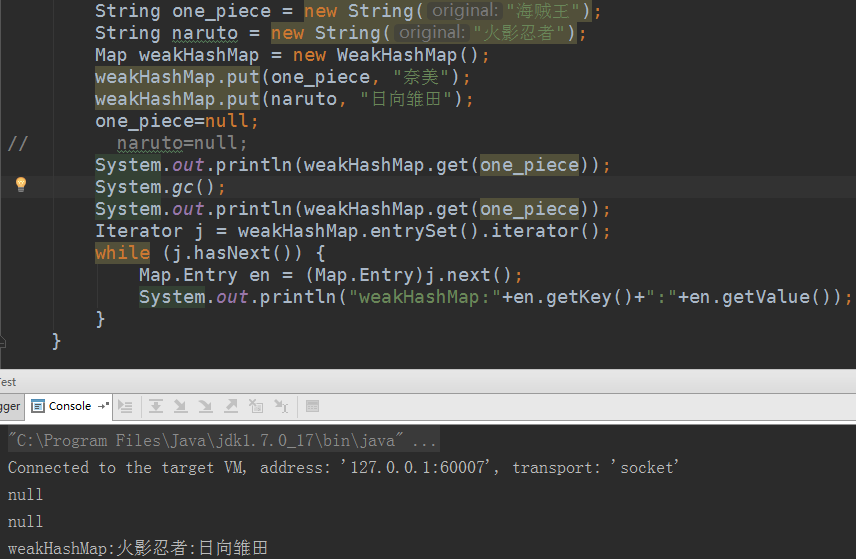@kiraSally
2018-03-12T10:44:39.000000Z
字数 8477
阅读 3441
集合番@WeakHashMap一文通(1.7版)
JAVA COLLECTIONS 源码 1.7版本
- 笔者个人博客 kiraSally的掘金个人博客 感谢支持
1.预备知识:引用的相关知识
1.1 强引用(Strong Reference)
Object o = new Object();
- 强引用是Java 默认实现 的引用,JVM会尽可能长时间的保留强引用的存在(直到内存溢出)
- 当内存空间不足,Java虚拟机宁愿抛出
OutOfMemoryError错误,使程序异常终止,也不会靠随意回收具有强引用的对象来解决内存不足的问题:只有当没有任何对象指向它时JVM将会回收
1.2 软引用(Soft Reference)
public class SoftReference<T> extends Reference<T> {...}
- 软引用只会在虚拟机 内存不足 的时候才会被回收
- 软引用可以和一个引用队列(
ReferenceQueue)联合使用,如果软引用所引用的对象被垃圾回收器回收,Java虚拟机就会把这个软引用加入到与之关联的引用队列中
1.3 弱引用(Weak Reference)
public class WeakReference<T> extends Reference<T> {...}
- 弱引用是指当对象没有任何的强引用存在,在 下次GC回收 的时候它将会被回收
- 在垃圾回收器线程扫描它所管辖的内存区域的过程中,一旦发现了只具有弱引用的对象,不管当前内存空间足够与否,都会回收它的内存
- 需要注意的是:由于垃圾回收器是一个优先级很低的线程,因此不一定会很快发现那些只具有弱引用的对象
1.4 虚(或幻影)引用(Phantom Reference)
public class PhantomReference<T> extends Reference<T> {...public T get()return null;}}
- 虚引用形同虚设,与其他几种引用都不同,虚引用并不会决定对象的生命周期,get方法只返回null
- 如果一个对象仅持有虚引用,那么它就和没有任何引用一样,在任何时候都可能被垃圾回收器回收
- 唯一的作用就是可以用来 记录对象是什么时候被GC回收的(即跟踪对象被垃圾回收器回收的活动)
- 引用与软引用和弱引用的一个区别在于:虚引用必须和引用队列联合使用。当垃圾回收器准备回收一个对象时,如果发现它还有虚引用,就会在回收对象的内存之前,把这个虚引用加入到与之关联的引用队列中
2.WeakHashMap的定义
WeakHashMap是存储键值对(key-value)的非同步且无序的散列表,键和值都允许为null,基本跟HashMap一致- 特殊之处在于
WeakHashMap里的entry可能会被GC自动删除,即使没有主动调用remove()或者clear()方法 - 其键为弱键,除了自身有对key的引用外,此key没有其他引用那么此map会自动丢弃此值
- 在
《Effective Java》一书中第六条,消除陈旧对象时,提到了weakHashMap,用于短时间内就过期的缓存 - 由于与JDK1.7版本的HashMap实现原理一致(具体请参见笔者的 HashMap一文通),这里只讨论不同
- 若有机会写JVM篇的垃圾回收机制时会再进一步描述
Reference
3.WeakHashMap的数据结构
3.1 类定义
public class WeakHashMap<K,V>extends AbstractMap<K,V>implements Map<K,V>
3.2 重要全局变量
/*** The default initial capacity -- MUST be a power of two.* 默认容量,必须是2次幂*/private static final int DEFAULT_INITIAL_CAPACITY = 16;/*** The maximum capacity, used if a higher value is implicitly specified by either of the* constructors with arguments. MUST be a power of two <= 1<<30.* 最大容量,必须为2次幂且 <= 1<<30*/private static final int MAXIMUM_CAPACITY = 1 << 30;/*** The load factor used when none specified in constructor.* 负载因子*/private static final float DEFAULT_LOAD_FACTOR = 0.75f;/*** The table, resized as necessary. Length MUST Always be a power of two.* 容量必须为2次幂的数组*/Entry<K,V>[] table;/*** The number of key-value mappings contained in this weak hash map.* 拥有键值对的数量*/private int size;/*** The next size value at which to resize (capacity * load factor).* 阈值 -- 扩容判断依据*/private int threshold;/*** The load factor for the hash table.*/private final float loadFactor;/*** Reference queue for cleared WeakEntries* 引用队列,用于存储已被GC清除的WeakEntries*/private final ReferenceQueue<Object> queue = new ReferenceQueue<>();
3.3 构造器
// 默认构造函数WeakHashMap()// 指定"容量大小"的构造函数WeakHashMap(int capacity)// 指定"容量大小"和"负载因子"的构造函数WeakHashMap(int capacity, float loadFactor)// 包含"子Map"的构造函数WeakHashMap(Map<? extends K, ? extends V> map)
实现跟JDK1.7版本HashMap的实现一致,具体请参见笔者的 HashMap一文通
3.4 Entry
/*** The entries in this hash table extend WeakReference, using its main ref field as the key.* 该Enty继承WeakReference,从而具备弱引用的特性*/private static class Entry<K,V> extends WeakReference<Object> implements Map.Entry<K,V> {V value;int hash;Entry<K,V> next;//链表/*** Creates new entry.*/Entry(Object key, V value,ReferenceQueue<Object> queue,int hash, Entry<K,V> next) {super(key, queue);this.value = value;this.hash = hash;this.next = next;}....}
4.WeakHashMap的重点知识
4.1 弱键回收
- 创建
WeakHashMap对象,执行put()新增键值对- 当某
weakKey不再被其它对象引用,将被GC回收,同时该key会被添加到ReferenceQueue(queue)队列中- 当
WeakHashMap执行新的操作时,会先同步table和queue;其中table中保存了全部的键值对,而queue中保存被GC回收的key(同步即删除table中被GC回收的键值对)
4.2 特殊情况
- 当使用 WeakHashMap 时,即使没有显示的添加或删除任何元素,也可能发生如下情况(源自JavaDoc):
- 调用两次
size()方法返回不同的值;- 两次调用
isEmpty()方法,第一次返回false,第二次返回true;- 两次调用
containsKey()方法,第一次返回true,第二次返回false,尽管两次使用的是同一个key;- 两次调用
get()方法,第一次返回一个value,第二次返回null,尽管两次使用的是同一个对象。
4.3 应用场景
- 根据其回收特性,可以用作缓存,但由于其的不可控性,导致其的使用非常有限
- stackoverFlow对于该问题的描述
- 解决方案集合 (吐槽一下翻译)
//如当做线程的metaData信息记录,可用于查看当前的alive线程数和相关情况WeakHashMap<Thread, SomeMetaData>
5.WeakHashMap的重点方法
5.1 put方法
/*** Associates the specified value with the specified key in this map.* If the map previously contained a mapping for this key, the old value is replaced.* 若该key对应的映射(值)已经存在,会覆盖旧值* @param key key with which the specified value is to be associated.* @param value value to be associated with the specified key.* @return the previous value associated with <tt>key</tt>, or* <tt>null</tt> if there was no mapping for <tt>key</tt>.* (A <tt>null</tt> return can also indicate that the map* previously associated <tt>null</tt> with <tt>key</tt>.)*/public V put(K key, V value) {Object k = maskNull(key);int h = hash(k);//插入操作会 做一次过期对象清洗操作,其他与HashMap一致Entry<K,V>[] tab = getTable();int i = indexFor(h, tab.length);for (Entry<K,V> e = tab[i]; e != null; e = e.next) {if (h == e.hash && eq(k, e.get())) {V oldValue = e.value;if (value != oldValue)e.value = value;return oldValue;}}modCount++;Entry<K,V> e = tab[i];//新建的Entry对象需要持有queue引用tab[i] = new Entry<>(k, value, queue, h, e);if (++size >= threshold)resize(tab.length * 2);//同样是扩容2倍return null;}
5.2 get方法
/*** Returns the value to which the specified key is mapped,* or {@code null} if this map contains no mapping for the key.* 若key所对应的值不存在,返回null* @see #put(Object, Object)*/public V get(Object key) {Object k = maskNull(key);int h = hash(k);//为了每次获取map中的元素的时候都能从已经自动清理过后的table数组中获取,会先执行清洗操作Entry<K,V>[] tab = getTable();int index = indexFor(h, tab.length);Entry<K,V> e = tab[index];while (e != null) {if (e.hash == h && eq(k, e.get()))return e.value;e = e.next;}return null;}

5.3 resize方法
/*** Rehashes the contents of this map into a new array with a* larger capacity. This method is called automatically when the* number of keys in this map reaches its threshold.* If current capacity is MAXIMUM_CAPACITY, this method does not* resize the map, but sets threshold to Integer.MAX_VALUE.* This has the effect of preventing future calls.* 当前容量若已为MAXIMUM_CAPACITY,则扩容为Integer.MAX_VALUE* @param newCapacity the new capacity, MUST be a power of two;* must be greater than current capacity unless current* capacity is MAXIMUM_CAPACITY (in which case value is irrelevant).必须是2次幂*/void resize(int newCapacity) {Entry<K,V>[] oldTable = getTable();//扩容操作会执行一次过期对象清洗操作int oldCapacity = oldTable.length;if (oldCapacity == MAXIMUM_CAPACITY) {threshold = Integer.MAX_VALUE;return;}Entry<K,V>[] newTable = newTable(newCapacity);boolean oldAltHashing = useAltHashing;useAltHashing |= sun.misc.VM.isBooted() &&(newCapacity >= Holder.ALTERNATIVE_HASHING_THRESHOLD);boolean rehash = oldAltHashing ^ useAltHashing;transfer(oldTable, newTable, rehash);table = newTable;/** If ignoring null elements and processing ref queue caused massive* shrinkage, then restore old table. This should be rare, but avoids* unbounded expansion of garbage-filled tables.* 若忽视null和处理引用队列将会导致Map中的元素数量大量减少,从而会修复旧数组* 这种情况比较稀少,但仍要避免 堆满垃圾对象的数组的无限拓展*/if (size >= threshold / 2) { //当长度>=阈值的一半时,需要重新计算阈值threshold = (int)(newCapacity * loadFactor);} else {//当长度<阈值的一半时(多半是null或弱引用过期导致),会重新修复数组expungeStaleEntries();transfer(newTable, oldTable, false);table = oldTable;}}/*** Returns the table after first expunging stale entries.* 返回清洗过后的table*/private Entry<K,V>[] getTable() {expungeStaleEntries();return table;}
5.4 clear方法
/*** Removes all of the mappings from this map.* The map will be empty after this call returns.* 清空Map*/public void clear() {// clear out ref queue. We don't need to expunge entries since table is getting cleared.// 直接清空queue即可,不需要再额外地执行清洗操作while (queue.poll() != null);modCount++;//结构性修改Arrays.fill(table, null);//数组清空操作推荐以后时候该封装方法size = 0;// Allocation of array may have caused GC, which may have caused additional entries to go stale.// Removing these entries from the reference queue will make them eligible for reclamation.// 数组分配操作可能会触发GC,从而可能导致新增的元素直接过期// 这时候需要再执行一次queue清空操作从而使新增元素能被合理地回收while (queue.poll() != null);}
5.5 expungeStaleEntries方法
weakKey(弱键)是一个弱引用(WeakReference),其目的:实现对"键值对"的动态回收,- 当
弱键不再被使用到时,GC会回收它,WeakReference也会将弱键对应的键值对删除- 在Java中,
WeakReference和ReferenceQueue是联合使用的,入队时机参见enqueue方法- 在
WeakHashMap中:如果弱引用所引用的对象被垃圾回收,Java虚拟机就会把这个弱引用加入到与之关联的引用队列中,之后WeakHashMap会根据引用队列,来删除已被GC回收的弱键对应的键值对- GC判断某个对象是否可被回收的依据是,是否有有效的引用指向该对象
/*** Expunges stale entries from the table. -- 删除过时的entry* 该方法是实现弱键回收的最关键方法,也是区分HashMap的根本方法* 核心:移除table和queue的并集元素(queue中存储是已被GC的key,注意是key!!)* 效果:key在GC的时候被清除,value在key清除后访问WeakHashMap被清除*/private void expungeStaleEntries() {//从队列中出队遍历//poll 移除并返问队列头部的元素;如果队列为空,则返回nullfor (Object x; (x = queue.poll()) != null; ) {synchronized (queue) {//值得一提的是WeakHashMap是非线程安全的,这里却同步了一下//大神原本的用意是保证在多线程时能不破坏数据结构,但JavaDoc已经强调这类非安全,如下文//http://bugs.java.com/bugdatabase/view_bug.do?bug_id=6425537@SuppressWarnings("unchecked")Entry<K,V> e = (Entry<K,V>) x;//找到该队列中的元素在数组中的位置,并移除该元素(table和queue都需要移除)int i = indexFor(e.hash, table.length);Entry<K,V> prev = table[i];Entry<K,V> p = prev;while (p != null) {Entry<K,V> next = p.next;if (p == e) {if (prev == e)table[i] = next;elseprev.next = next;// Must not null out e.next;// stale entries may be in use by a HashIteratore.value = null; // Help GC 移除valuesize--;break;}prev = p;p = next;}}}}
集合番@WeakHashMap一文通(1.7版) 由 黄志鹏kira 创作,采用 知识共享 署名-非商业性使用 4.0 国际 许可协议 进行许可。
本站文章除注明转载/出处外,均为本站原创或翻译,转载前请务必署名。
